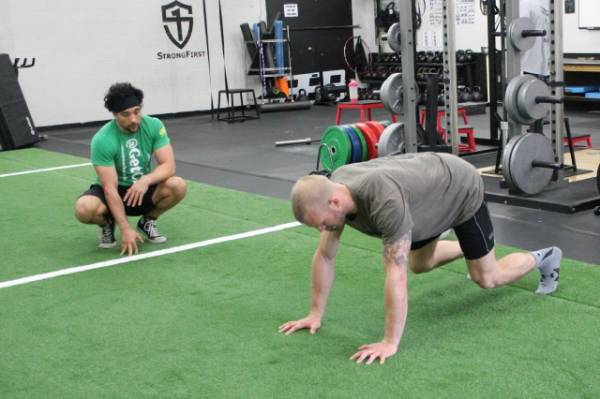When people are training for optimal power output, they push themselves harder, faster, stronger, and longer. The mission is to kick your ass to be a badass.
But what most often happens is the brain and body hit a breaking point in their ability to recover – leading to a constant state of exhaustion. Instead of optimal power, you get overtraining, fatigue, decreased durability, and most likely injury. Is this sounding familiar at all?
When people are training for optimal power output, they push themselves harder, faster, stronger, and longer. The mission is to kick your ass to be a badass.
But what most often happens is the brain and body hit a breaking point in their ability to recover – leading to a constant state of exhaustion. Instead of optimal power, you get overtraining, fatigue, decreased durability, and most likely injury. Is this sounding familiar at all?
Step Backward to Move Forward
The secret sauce you need is the concept of regress to progress. Back off the training throttle and allow the nervous system to work for you instead of against you. The brilliant strength-training programmer Paul Mcllroy said, “Strength isn’t built. It’s granted by your nervous system.” Take a moment to let that one sink into your brain.
Crawling has many neurological and muscular benefits that can help you rediscover lost movement.
If your nervous system perceives a threat, it will back off the power switch. So, the goal is to expand the comfort zone in training, and your power will naturally increase without extra effort. And what better way to feel more comfortable than to get back down on the ground where we all started moving?
Let’s revisit some fundamental movement patterns. Creeping and crawling are fundamental motions that prime the nervous system to pattern force for the goal of walking. Let’s discover specifically how the crawl relates to one of the most important fascial lines in force production – the ipsilateral functional line.
The Role of Stress in Strength
Stress is actually a good thing in training because it prepares us for high-output response, but too much stress does the exact opposite. The concept of general adaptation syndrome, coined by famed endocrinologist Dr. Hans Seyle, discovered there are three phases to adaptation.1
- Alarm phase – This is the physiological response to a perceived stressor. As the brain perceives a stressful situation, it stimulates a cascade of hormonal and neurological changes such as increased heart rate and blood pressure.
- Resistance phase – Here, the body is adapting and learning to tolerate a repeated stressor by becoming stronger and more resistant to that stressor. If a stressor is repeated too often, without adequate time to recover, the body enters the third stage.
- Exhaustion – This phase results in maladaptation and non-optimal performance.
Taking time to regress movement patterns and expand the training comfort zone is critical for recovery and performance. We can do this with ipsilateral crawling, which will take advantage of the fascial force transmission system of the body allowing for efficient power output in a safe environment, the ground.

The Ipsilateral Functional Fascial Line and Why It Matters
Taken from the work of Thomas Myers and his groundbreaking book Anatomy Trains, the ipsilateral functional line includes the fascial connection of the ipsilateral latissimus dorso, external oblique, and sartorius muscle:
This line can be felt when supporting the body on the latissimus as on the rings, or on swimming when pulling the hand down through the water in a crawl stroke. Hanging from a chinning bar or a tree branch and twisting the pelvis and legs will also bring this line into awareness.2
You feel this line when standing and bringing the same side knee and elbow together in flexion by your side in the frontal plane. It’s the exact motion of the unilateral creeping position you see baby and kids do while learning to move.
When muscles contract, not only do they move bones, but due to these fascial expansions, they also stretch the deep fascia. Myofascial expansions permit reciprocal feedback between fascia and muscle producing force and tension over a distance. The crawl movement takes advantage of this tensional network.
“Your nervous system with thank you and your competition will be wondering what went wrong with their training.Now go crawl and be a badass.”
Reset Your Movement
To optimise function of this line we want to do a RAIL reset of the muscle pattern. RAIL is the acronym for a system of correction I developed for my workshops. It stands for release, activate, integrate, locomotion.
We are going to release facilitated and overworking muscle and/or fascia, activate the inhibited underworked muscles, and integrate them into a fundamental pattern. Then, we stand and open up full throttle. This system takes advantage of the nervous system comfort zone by increasing movement demand via stages.
Release the latissimus, external oblique, and sartorius (muscle that goes from the anterior superior iliac spine of the pelvis diagonally across the thigh to the inner knee) with foam roller. Be careful with pressure into the sides near the external oblique. You may have to use your hand instead of the roller to release the oblique if they are too tender. Release both sides.
Activate and integrate with the unilateral crawl:
The key is to go slow in the beginning. Do one set chunking style. This means in sections, moving the arm first and then the leg. This is easier for the brain to pattern. Do one set like that on each side.
Now take four seconds to complete the movement each way. Do not hold your breath. Turn your head to the right. Bring your right knee and right elbow together, sliding on the ground. Take four seconds to do the movement. Hold and relax four seconds. Return to starting position taking four seconds. Repeat the motion on the opposite side.
“Taking time to regress movement patterns and expand the training comfort zone is critical for recovery and performance.”
Perform four repetitions total, two on each side. Then do another four reps total, two on each side, at regular speed. Do not hold your breath.
Locomotion happens when we stand up and bring the same-side knee and elbow together on each side at normal speed for four times total. Then, perform ten skips forward.
Warming Up
Do this reset as a warm-up exercise every time you want to train. Take the time to slow down and visit primal patterns that are inherent to our body’s ability to control motion.
Your nervous system will thank you and your competition will be wondering what went wrong with their training. Now go crawl and be a badass.
Check out these related articles:
- Regain and Build Your Original Strength Through Crawling
- Ground Control – How to Move Efficiently On All Fours
- Move Your Body, Move Your Brain – Training for Neuroplasticity
- What’s New On Breaking Muscle UK Today
References:
1. Daane, Marcel. Headstrong Performance.(Singapore: 2015).
2. Myers, Thomas W. Anatomy Trains: Myofascial Meridians for Manual and Movement Therapists. (Edinburgh: Churchill Livingstone, 2001).
3. Stecco, Carla, Warren I. Hammer, Andry Vleeming, and Raffaele De Caro.Functional Atlas of the Human Fascial System. (Churchill Livingstone, 2015).
Photos courtesy of Shannon Khoury.






